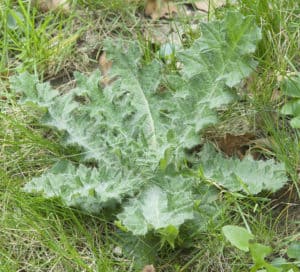Knotweed Organic Weed Control
Knotweed grows from long-lived rhizomes but plants live as annuals growing in lawns, vegetable gardens, and ornamental gardens especially where the soil is compacted.
Botanical name: Polygonum aviculare
Organic Weed Control at Amazon
- Monterey Vegetable Pre-Emergent Weed Control
- Homietina Heavy Duty Weed Barrier Fabric 4×300-feet
- Preen Natural Vegetable Garden Weed Preventer
- Green Gobbler 20% Vinegar Weed and Grass Killer
- WeedGuard Plus Biodegradable Paper Weed Barrier

Knotwood description and life cycle
- Germinates late winter to mid-spring,
- Stems are 4 inches to 24 inches long; stems are swollen at the joints.
- Wiry stems form a mat on the soil surface; prostrate growing.
- Slender, ridged stems radiate from taproot in all directions.
- Blue-green elliptical leaves alternate on the stem; leaves are ½ to 1 inch long, and 3/8 inch wide.
- Small white or pink flowers grow in clusters from axils formed by the sheath and petiole.
- Blooms early summer to fall.
- Reproduces by seed and by spreading roots called rhizomes.
- Knotweed thrives in compact soil.
Knotweed root system
Knotweed grows from fibrous roots that produce spreading rhizomes. Each lateral shoot can extend 25 to 40 feet. Rhizomes can grow as deep as 7 feet. Individual plants can be 8 to 15 feet in diameter or larger and clumps can cover several hundred square feet to several acres. New plants are produced from nodes along spreading rhizomes. Tops die back in cold winter regions but regrow from roots rapidly in spring.
Knotweed organic control
- Hand-pull when plants are young and the soil is soft.
- Hoe mature plants; cut the crown of the plant below the soil surface or dig out the root.
- Remove rhizome roots; any rhizome remaining in the soil will produce new plants at each node. A plant that develops extensive roots will be nearly impossible to control completely. Even small fragments of roots will produce new plants.
- Pull up new sprouting plants as soon as they appear. Continue as long as necessary.
- Cover the area where plants have been removed with landscape fabric, cardboard, or black plastic mulch to keep new plants from sprouting. Knotweed has been known to grow through asphalt.
- Turn the soil; knotweed thrives in compacted soil.
- Mulch to prevent seed from germinating.
Knotweed range
Throughout the United States and southern Canada.
Four quick ways to control weeds
- Weed early. Control weeds in the first month after they germinate.
- Weed often. Hand weed every two weeks through the season.
- Weed by hand when the soil is wet (best to get roots).
- Use a hoe if the soil is dry. Decapitate weeds before they flower and drop seed.
Related articles:
Vegetable Garden Organic Weed Control
Vegetable Garden Organic Pest Control
Vegetable Garden Diseases Problem Solver
Garden Planning Books at Amazon:
- Vegetable Garden Almanac & Planner
- Kitchen Garden Grower’s Guide Vegetable Encyclopedia
- Vegetable Garden Grower’s Guide
- Tomato Grower’s Answer Book






